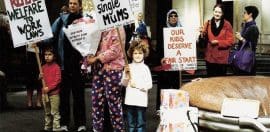The job market is bouncing back, but not for everyone

21 October 2021 at 8:12 am
New data finds there are 27 jobseekers across Australia competing for each entry-level job
While many are labelling Australia’s low unemployment rate a success, new analysis from Anglicare Australia shows that for people facing barriers to work, finding a job is harder than ever before.
The annual Jobs Availability Snapshot examines how many entry-level jobs are available for job seekers with barriers to work – such as people with disability, those in remote areas, and people who didn’t finish year 12.
Released on Thursday to coincide with Anti-Poverty Week, this year’s report found that job seekers across the country who didn’t have qualifications or experience to draw on, outnumbered the amount of entry-level vacancies by as many as eight to one.
Key figures remain stubborn
In 2020, the snapshot found that the total number of people in the government’s privatised employment services program Jobactive had ballooned out from 619,956 in 2019 to 1,442,760. In 2021, this figure only dropped to 1,013,452.
When it came to the number of people in Stream C of the Jobactive system (those who need the most support to find and keep work), only dropped from 106,620 in 2020 to 104,457 in 2021.
Anglicare Australia executive Kasey Chambers told Pro Bono News that people in Stream C spent an average of five years looking for work, which was a long time to be living in poverty.
“An average of five years is a long time to be on JobSeeker which we all know is far too little a payment to be living on,” Chambers said.
While this year saw an improvement in the number of people competing for entry-level jobs – 27 compared to 106 in 2020 – the report said this showed the employment rate recovery was being driven by the most employable job seekers taking the most easily available jobs.
High rates of underemployment (1.6 million people) across the country also increased demand for these entry level jobs, as people sought more hours and second jobs.
The report noted that the overall low unemployment rate “wasn’t because everyone who wants a job has one”.
“Instead, many people are giving up on looking for work and dropping out of the workforce entirely,” the report said.
“Others are technically employed, but are working zero hours each week. The number of people in the labour force is dropping, and rates of underemployment remain high.”
Job seekers must be supported
Chambers said that many community and charity organisations were trying to help job seekers with barriers to work by using innovative employment programs that hire people based on aptitude rather than qualifications.
She gave the example of the aged care NFP, Benetas.
“They look for the right aptitude and then train those people instead of looking for the right qualification,” she said.
“So if you’ve had a big break from work and don’t have specific qualifications for a job, this can be really beneficial.”
But, she added that if people with barriers were forced to keep competing in a saturated job market, nothing would ever improve.
Instead, she said that government interventions such as introducing a permanent basic income to keep people above the poverty line, an investment in industries such as aged care and disability support, and abandoning mutual obligations would be much more beneficial to people facing barriers to work.
“Realistically, we need government help because if people are just on that very low level of JobSeeker or Youth Allowance while they’re searching for jobs it’s going to be really hard for them, ” she said.
A full copy of the report can be found here.








These reports, and others like it, do show that the Government needs to do more to support jobseekers. However, they miss a fundamental flaw… a ‘target’ or ‘low’ level of unemployment, currently 4.5% according to our Treasurer, means there are well over 600,000 Aussies capable of some work, for whom no job exists. These folk are almost certainly in the group who find the most difficulty getting a job, for a variety of reasons, but importantly – assuming merit based employment practices – these folks will *always* remain the least employable. Making these people go for jobs that simply don’t exist, suffer the indignity and stress of living below the poverty line, AND becoming subject for the long term effects of being derided and ‘othered’ as failures is cruel. COVID19 has caused a money-printing frenzy throughout the western world like nothing seen before, yet John Howard & Milton Friedman’s sham NAIRU has proven to be the cruel nonsense we all knew it was, with inflation remaining resolutely low, despite the cash washing through the economy. Please, let us urgently treat people better… more than half a million Australian citizens will never find a job under this Government’s policies… either create full employment, or pay *everyone* at least the level of the Aged Pension so that they can live in dignity and participate in society.
Covid has presented me with a different issue of having people recently release (within 3 weeks) employed yet still living in Crisis Temporary Accomodation. Working Everyday yet unable to negotiate the perils of the private property market they are living in hotels in crisis accommodation unable to inspect properties through fear of losing their jobs.